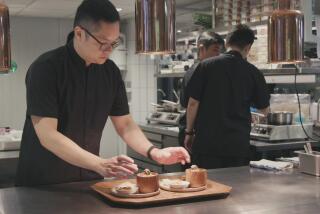Face of old Singapore gets a little bit of color
- Share via
SINGAPORE — It is easy to see Singapore’s role as a modern business hub when looking at its skyscraper skyline, homogeneous public housing and resort-style condominiums.
But this tiny Southeast Asian nation has a colorful, multicultural past that is still evident in scattered pockets of older districts that escaped redevelopment, and the government is working to ensure that history doesn’t disappear.
Across the island, dilapidated shophouses have been shored up, window frames repainted in bright yellows, reds, blues and greens, and the insides renovated for modern uses, be it a 7-Eleven store, a photo gallery or a boutique hotel.
Colonial bungalows are being adapted into offices or split into upscale apartments. Old schools get face-lifts to house new corporate tenants or a museum.
“Conserving older buildings and rehabilitating them for future use is an essential part of what Singapore is. We need to preserve our past,” said James Toh of A.C.T. Holdings Pte Ltd., a development company that has won national awards for its conservation work.
Singapore’s history dates to 1819, when the British established a trading post at what had been a small fishing community just off the southern tip of the Malay Peninsula. As the thriving port grew, Chinese, Malays, Indians and other ethnic groups moved in.
Each group built its own version of Southeast Asia’s shophouses -- narrow buildings mostly with a business on the ground floor and living quarters on one or two upper floors, roofed with clay tiles. Indians kept theirs low and simple; Chinatown incorporated carved woodwork and pastel colors; the Chinese-Malay community added plaster or ceramic tiles.
In other parts of the island, Europeans built large, terraced homes with ornate facades, or coastal bungalows that combined Western and local building traditions.
The Urban Redevelopment Authority has been encouraging adaptive reuse of the old buildings, and since the early 1980s has approved 6,560 for preservation, many of them in the Chinatown, Little India, Kampong Glam and Boat Quay neighborhoods.
Other preserved and restored buildings include the original Parliament house and a former Roman Catholic boys school turned into the Singapore Art Museum. The Raffles Hotel, opened in 1887 to honor British founder, Sir Stamford Raffles, is a whitewashed, restored reminder of Singapore’s colonial period.
The URA is now looking at post-World War II structures to protect, based on historical and social significance. Its efforts have been lauded as Southeast Asia’s first large-scale urban conservation program, and it was honored in July by the Urban Land Institute, an international nonprofit education and research body.
While initially tackling restoration projects on its own -- an approach that some complain resulted in unimaginative, cookie-cutter renovations in Chinatown -- the government now auctions off conservation projects.
Developers generally must retain a structure’s entire facade. But in some cases, depending on the building and its location, the rules require only the retention of a portion -- usually the front face -- and allow for additions to the back or side.
Interiors, however, can be adapted in any way for reuse.
“It was exciting to consider ways to energize this old building,” architect Tai Lee Siang said of the New Majestic Hotel, a 1928 Chinatown building whose innovative restoration was recognized in September with a national Architectural Heritage award. “It’s about finding ways to make the new very new and yet keep the old old.”
Built as a hotel comprising four shophouses in 1928, and with a restaurant that was popular until the 1970s, the Majestic had declined by the time Loh Lik Peng of KMC Holdings bought it in 2003.
Following the URA guidelines, the hotel’s exterior was restored, down to finding exact matching tiles that were missing from some balconies.
But from there, architect Tai and owner Loh had the freedom to be as eclectic as their $1.9-million budget allowed.
The original ceiling, with chipped paint and metal fan hooks, remains in the lobby, offering a stark contrast to the wide, natural-lit space with its modern furniture and 1970s-era glass baubles hanging over a spiral staircase. A patio swimming pool includes portholes on the bottom that reflect waves into the hotel dining room below.
Some rooms have bathtubs on enclosed balconies, and each room was independently decorated by a local artist in a theme of his choosing, including an all-mirrored room and an aquatic-themed room with a huge goldfish suspended over the bed.
“You can put new and old together in very interesting ways,” Tai said.
More to Read
Sign up for Essential California
The most important California stories and recommendations in your inbox every morning.
You may occasionally receive promotional content from the Los Angeles Times.













